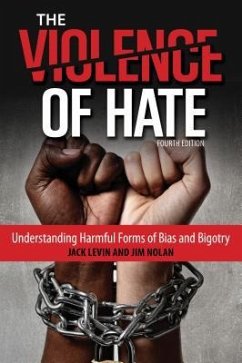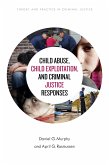- Broschiertes Buch
Andere Kunden interessierten sich auch für
![Tough on Hate? Tough on Hate?]() Clara S LewisTough on Hate?48,99 €
Clara S LewisTough on Hate?48,99 €![Why Do Americans Hate Americans? Why Do Americans Hate Americans?]() Daniel WilliamsWhy Do Americans Hate Americans?23,99 €
Daniel WilliamsWhy Do Americans Hate Americans?23,99 €![Hate Crimes and Ethnoviolence Hate Crimes and Ethnoviolence]() Howard J EhrlichHate Crimes and Ethnoviolence59,99 €
Howard J EhrlichHate Crimes and Ethnoviolence59,99 €![What Is a Hate Crime? What Is a Hate Crime?]() What Is a Hate Crime?34,99 €
What Is a Hate Crime?34,99 €![Uneasy Peace Uneasy Peace]() Patrick SharkeyUneasy Peace16,99 €
Patrick SharkeyUneasy Peace16,99 €![Family Activism in the Aftermath of Fatal Violence Family Activism in the Aftermath of Fatal Violence]() Elizabeth A. CookFamily Activism in the Aftermath of Fatal Violence66,99 €
Elizabeth A. CookFamily Activism in the Aftermath of Fatal Violence66,99 €![Child Abuse, Child Exploitation, and Criminal Justice Responses Child Abuse, Child Exploitation, and Criminal Justice Responses]() Daniel G MurphyChild Abuse, Child Exploitation, and Criminal Justice Responses96,99 €
Daniel G MurphyChild Abuse, Child Exploitation, and Criminal Justice Responses96,99 €-
-
-
Produktdetails
- Verlag: Globe Pequot Publishing Group Inc/Bloomsbury
- 4th edition
- Seitenzahl: 248
- Erscheinungstermin: 8. Juli 2016
- Englisch
- Abmessung: 226mm x 152mm x 13mm
- Gewicht: 363g
- ISBN-13: 9781442260504
- ISBN-10: 1442260505
- Artikelnr.: 44675796
Hinweis: Dieser Artikel kann nur an eine deutsche Lieferadresse ausgeliefert werden.
- Herstellerkennzeichnung
- Libri GmbH
- Europaallee 1
- 36244 Bad Hersfeld
- gpsr@libri.de
Jack Levin is Professor Emeritus of Sociology and Criminology and codirector of the Brudnick Center on Violence and Conflict at Northeastern University. He has published more than 30 books and numerous journal articles and newspaper columns, primarily in the areas of hate crimes, sociology of prejudice, school violence, and multiple homicide. Levin was honored by the Massachusetts Council for the Advancement and Support of Education as its "Professor of the Year." He recently received an award from the American Sociological Association for his contributions to the public understanding of sociology and also was the recipient of the Apple Award from the New England Sociological Association and the Lester Ward Award from the Association of Applied and Clinical Sociology. In 2013, he received a Lifetime Achievement Award for his research in criminology from the Society for the Study of Social Problems. Jim Nolan is a professor in the Department of Sociology and Anthropology at West Virginia University where he teaches courses on the topic of crime and social control. His research currently focuses on urban policing, intergroup relations and hate crimes, and the measurement of crime. He has been the recipient of research funding from several U.S. Department of Justice agencies and the National Science Foundation. Dr. Nolan is currently serving on a National Academy of Sciences panel on modernizing the nation's crime statistics. His research publications have appeared in the American Behavioral Scientist, Journal of Quantitative Criminology, Journal of Contemporary Criminal Justice, Policing & Society, Criminal Justice Studies, Homicide Studies, Journal of Criminal Justice, and The American Sociologist. Dr. Nolan was the 2010 recipient of the Carnegie Foundation for the Advancement of Teaching and Council for Advancement and Support of Education (CASE) West Virginia Professor of the Year.
1. Perspectives on Hate and Violence Hate, Prejudice, and Discrimination
Transforming the Terms Prejudice versus Discrimination The Role of the
Individual Justifying Hate Violence The Influence of Significant
Others From Individual to Institutional Discrimination Constructing Group
Identity Who Controls an Individual's Group Identity? Changing Group
Identity The Privilege of White Identity When Stereotypes Turn Nasty Is
Hate on the Decline? Underestimating Bigotry Unconscious Bias The
Difference Between Small and Insignificant Hate Crimes are Vastly
Under-Reported It Takes Only a Few Bad Apples Conclusion 2. Explaining
the Violence of Hate Environment, Heredity, and the Power of the Situation
The Environmental View-Blaming the Victim The Hereditary View-Blaming the
Victim A Situationist View of Hate Violence Threatening Situations Can
Inspire Hate Hate Crimes Against Muslims Hate Crimes Against Immigrants The
New Anti-Semitism A Continuing Racial Gap The Obama Factor Bashing Gays and
Lesbians Hate Crimes Against Women Conclusion 3. Hate Crimes Motive
Matters The Hate Crime Statistics Act The FBI's Uniform Crime Reporting
Program NIBRS Hate Crime Data Why Now? Pros and Cons of Hate Crime Laws
Hate Crime Laws Today Federal Civil Rights Statutes The Matthew Shepard and
James Byrd Jr. Hate Crimes Prevention Act State Hate Crime Statutes Hate
Crime Laws and the U.S. Constitution Policing Hatred When the Police Are
Viewed as Perpetrators of Hate Violence When the Police Are Viewed as
Victims of Hate Violence Explaining Bias in Policing Bourdieu's Theory of
Practice: A Sociological Perspective on Police Violence The Traffic
Enforcement Analogy: A Sociological Explanation Policing Hate Crimes Seeing
Hate Crimes Intension and Extension of the Term "Hate Crime" Classification
of Hate Crime Incidents Why Is This Distinction Important? Hate Crimes in
Europe The Roma in Europe Sexual Orientation and Gender Identity Violence
Conclusion 4. A Typology of Hate Hatemongers The Role of Organized Hate
Hate from a Distance Biblical Bigotry The Militia Movement and White
Supremacy Expanding the Influence of Organized Hate Mass Murder in the Name
of Hate Dabblers Getting a Thrill Being Defensive Getting Even Sympathizers
Behind Closed Doors An Eliminationist Anti-Semitism Cultural Hate Culture
Transcends Generations Spectators The Failure to Act Middleman Minorities
Middleman Minorities in the United States The American Version of
Spectatorship Conclusion 5. The Benefits of Bigotry Protest by Proxy
Psychological Advantages Enhancing and Protecting Self-Esteem Reducing
Uncertainty Economic and Status Advantages Getting the Dirty Work Done
Eliminating Opponents Maintaining Political Power Conclusion 6. The
Production of Rebels, Deviants, and Other Decent People The Power of the
Situation When Normal People Do Abnormally Nasty Things Fighting
Spectatorship Intergroup Contact The Impact of Competition Reducing
Hostility Between Groups Structuring Opportunities for Cooperation Follow
the Leader Obeying Orders The Role of Leadership The Impact of Deviance
When Rebels Rebel The Importance of Empathy Across Groups Human Agency: The
Ability to Create "Good" Situations The Agentic Perspective Collective
Efficacy in Neighborhoods Neighborhood Agency and Collective Efficacy
Conclusion Appendix A. Anti-Hate Websites Appendix B. Division E-Matthew
Shepard and James Byrd, Jr. Hate Crimes Prevention Act
Transforming the Terms Prejudice versus Discrimination The Role of the
Individual Justifying Hate Violence The Influence of Significant
Others From Individual to Institutional Discrimination Constructing Group
Identity Who Controls an Individual's Group Identity? Changing Group
Identity The Privilege of White Identity When Stereotypes Turn Nasty Is
Hate on the Decline? Underestimating Bigotry Unconscious Bias The
Difference Between Small and Insignificant Hate Crimes are Vastly
Under-Reported It Takes Only a Few Bad Apples Conclusion 2. Explaining
the Violence of Hate Environment, Heredity, and the Power of the Situation
The Environmental View-Blaming the Victim The Hereditary View-Blaming the
Victim A Situationist View of Hate Violence Threatening Situations Can
Inspire Hate Hate Crimes Against Muslims Hate Crimes Against Immigrants The
New Anti-Semitism A Continuing Racial Gap The Obama Factor Bashing Gays and
Lesbians Hate Crimes Against Women Conclusion 3. Hate Crimes Motive
Matters The Hate Crime Statistics Act The FBI's Uniform Crime Reporting
Program NIBRS Hate Crime Data Why Now? Pros and Cons of Hate Crime Laws
Hate Crime Laws Today Federal Civil Rights Statutes The Matthew Shepard and
James Byrd Jr. Hate Crimes Prevention Act State Hate Crime Statutes Hate
Crime Laws and the U.S. Constitution Policing Hatred When the Police Are
Viewed as Perpetrators of Hate Violence When the Police Are Viewed as
Victims of Hate Violence Explaining Bias in Policing Bourdieu's Theory of
Practice: A Sociological Perspective on Police Violence The Traffic
Enforcement Analogy: A Sociological Explanation Policing Hate Crimes Seeing
Hate Crimes Intension and Extension of the Term "Hate Crime" Classification
of Hate Crime Incidents Why Is This Distinction Important? Hate Crimes in
Europe The Roma in Europe Sexual Orientation and Gender Identity Violence
Conclusion 4. A Typology of Hate Hatemongers The Role of Organized Hate
Hate from a Distance Biblical Bigotry The Militia Movement and White
Supremacy Expanding the Influence of Organized Hate Mass Murder in the Name
of Hate Dabblers Getting a Thrill Being Defensive Getting Even Sympathizers
Behind Closed Doors An Eliminationist Anti-Semitism Cultural Hate Culture
Transcends Generations Spectators The Failure to Act Middleman Minorities
Middleman Minorities in the United States The American Version of
Spectatorship Conclusion 5. The Benefits of Bigotry Protest by Proxy
Psychological Advantages Enhancing and Protecting Self-Esteem Reducing
Uncertainty Economic and Status Advantages Getting the Dirty Work Done
Eliminating Opponents Maintaining Political Power Conclusion 6. The
Production of Rebels, Deviants, and Other Decent People The Power of the
Situation When Normal People Do Abnormally Nasty Things Fighting
Spectatorship Intergroup Contact The Impact of Competition Reducing
Hostility Between Groups Structuring Opportunities for Cooperation Follow
the Leader Obeying Orders The Role of Leadership The Impact of Deviance
When Rebels Rebel The Importance of Empathy Across Groups Human Agency: The
Ability to Create "Good" Situations The Agentic Perspective Collective
Efficacy in Neighborhoods Neighborhood Agency and Collective Efficacy
Conclusion Appendix A. Anti-Hate Websites Appendix B. Division E-Matthew
Shepard and James Byrd, Jr. Hate Crimes Prevention Act
1. Perspectives on Hate and Violence Hate, Prejudice, and Discrimination
Transforming the Terms Prejudice versus Discrimination The Role of the
Individual Justifying Hate Violence The Influence of Significant
Others From Individual to Institutional Discrimination Constructing Group
Identity Who Controls an Individual's Group Identity? Changing Group
Identity The Privilege of White Identity When Stereotypes Turn Nasty Is
Hate on the Decline? Underestimating Bigotry Unconscious Bias The
Difference Between Small and Insignificant Hate Crimes are Vastly
Under-Reported It Takes Only a Few Bad Apples Conclusion 2. Explaining
the Violence of Hate Environment, Heredity, and the Power of the Situation
The Environmental View-Blaming the Victim The Hereditary View-Blaming the
Victim A Situationist View of Hate Violence Threatening Situations Can
Inspire Hate Hate Crimes Against Muslims Hate Crimes Against Immigrants The
New Anti-Semitism A Continuing Racial Gap The Obama Factor Bashing Gays and
Lesbians Hate Crimes Against Women Conclusion 3. Hate Crimes Motive
Matters The Hate Crime Statistics Act The FBI's Uniform Crime Reporting
Program NIBRS Hate Crime Data Why Now? Pros and Cons of Hate Crime Laws
Hate Crime Laws Today Federal Civil Rights Statutes The Matthew Shepard and
James Byrd Jr. Hate Crimes Prevention Act State Hate Crime Statutes Hate
Crime Laws and the U.S. Constitution Policing Hatred When the Police Are
Viewed as Perpetrators of Hate Violence When the Police Are Viewed as
Victims of Hate Violence Explaining Bias in Policing Bourdieu's Theory of
Practice: A Sociological Perspective on Police Violence The Traffic
Enforcement Analogy: A Sociological Explanation Policing Hate Crimes Seeing
Hate Crimes Intension and Extension of the Term "Hate Crime" Classification
of Hate Crime Incidents Why Is This Distinction Important? Hate Crimes in
Europe The Roma in Europe Sexual Orientation and Gender Identity Violence
Conclusion 4. A Typology of Hate Hatemongers The Role of Organized Hate
Hate from a Distance Biblical Bigotry The Militia Movement and White
Supremacy Expanding the Influence of Organized Hate Mass Murder in the Name
of Hate Dabblers Getting a Thrill Being Defensive Getting Even Sympathizers
Behind Closed Doors An Eliminationist Anti-Semitism Cultural Hate Culture
Transcends Generations Spectators The Failure to Act Middleman Minorities
Middleman Minorities in the United States The American Version of
Spectatorship Conclusion 5. The Benefits of Bigotry Protest by Proxy
Psychological Advantages Enhancing and Protecting Self-Esteem Reducing
Uncertainty Economic and Status Advantages Getting the Dirty Work Done
Eliminating Opponents Maintaining Political Power Conclusion 6. The
Production of Rebels, Deviants, and Other Decent People The Power of the
Situation When Normal People Do Abnormally Nasty Things Fighting
Spectatorship Intergroup Contact The Impact of Competition Reducing
Hostility Between Groups Structuring Opportunities for Cooperation Follow
the Leader Obeying Orders The Role of Leadership The Impact of Deviance
When Rebels Rebel The Importance of Empathy Across Groups Human Agency: The
Ability to Create "Good" Situations The Agentic Perspective Collective
Efficacy in Neighborhoods Neighborhood Agency and Collective Efficacy
Conclusion Appendix A. Anti-Hate Websites Appendix B. Division E-Matthew
Shepard and James Byrd, Jr. Hate Crimes Prevention Act
Transforming the Terms Prejudice versus Discrimination The Role of the
Individual Justifying Hate Violence The Influence of Significant
Others From Individual to Institutional Discrimination Constructing Group
Identity Who Controls an Individual's Group Identity? Changing Group
Identity The Privilege of White Identity When Stereotypes Turn Nasty Is
Hate on the Decline? Underestimating Bigotry Unconscious Bias The
Difference Between Small and Insignificant Hate Crimes are Vastly
Under-Reported It Takes Only a Few Bad Apples Conclusion 2. Explaining
the Violence of Hate Environment, Heredity, and the Power of the Situation
The Environmental View-Blaming the Victim The Hereditary View-Blaming the
Victim A Situationist View of Hate Violence Threatening Situations Can
Inspire Hate Hate Crimes Against Muslims Hate Crimes Against Immigrants The
New Anti-Semitism A Continuing Racial Gap The Obama Factor Bashing Gays and
Lesbians Hate Crimes Against Women Conclusion 3. Hate Crimes Motive
Matters The Hate Crime Statistics Act The FBI's Uniform Crime Reporting
Program NIBRS Hate Crime Data Why Now? Pros and Cons of Hate Crime Laws
Hate Crime Laws Today Federal Civil Rights Statutes The Matthew Shepard and
James Byrd Jr. Hate Crimes Prevention Act State Hate Crime Statutes Hate
Crime Laws and the U.S. Constitution Policing Hatred When the Police Are
Viewed as Perpetrators of Hate Violence When the Police Are Viewed as
Victims of Hate Violence Explaining Bias in Policing Bourdieu's Theory of
Practice: A Sociological Perspective on Police Violence The Traffic
Enforcement Analogy: A Sociological Explanation Policing Hate Crimes Seeing
Hate Crimes Intension and Extension of the Term "Hate Crime" Classification
of Hate Crime Incidents Why Is This Distinction Important? Hate Crimes in
Europe The Roma in Europe Sexual Orientation and Gender Identity Violence
Conclusion 4. A Typology of Hate Hatemongers The Role of Organized Hate
Hate from a Distance Biblical Bigotry The Militia Movement and White
Supremacy Expanding the Influence of Organized Hate Mass Murder in the Name
of Hate Dabblers Getting a Thrill Being Defensive Getting Even Sympathizers
Behind Closed Doors An Eliminationist Anti-Semitism Cultural Hate Culture
Transcends Generations Spectators The Failure to Act Middleman Minorities
Middleman Minorities in the United States The American Version of
Spectatorship Conclusion 5. The Benefits of Bigotry Protest by Proxy
Psychological Advantages Enhancing and Protecting Self-Esteem Reducing
Uncertainty Economic and Status Advantages Getting the Dirty Work Done
Eliminating Opponents Maintaining Political Power Conclusion 6. The
Production of Rebels, Deviants, and Other Decent People The Power of the
Situation When Normal People Do Abnormally Nasty Things Fighting
Spectatorship Intergroup Contact The Impact of Competition Reducing
Hostility Between Groups Structuring Opportunities for Cooperation Follow
the Leader Obeying Orders The Role of Leadership The Impact of Deviance
When Rebels Rebel The Importance of Empathy Across Groups Human Agency: The
Ability to Create "Good" Situations The Agentic Perspective Collective
Efficacy in Neighborhoods Neighborhood Agency and Collective Efficacy
Conclusion Appendix A. Anti-Hate Websites Appendix B. Division E-Matthew
Shepard and James Byrd, Jr. Hate Crimes Prevention Act








